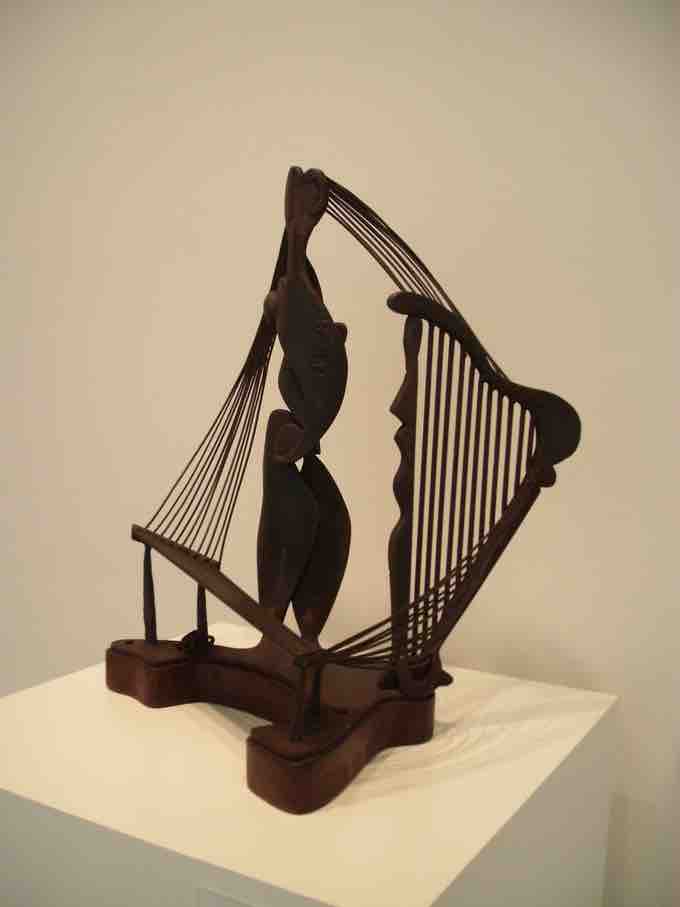Abstract Expressionism
While Abstract Expressionism is most closely associated with painting, a number of sculptors were integral to the movement as well. David Smith, Dorothy Dehner, Herbert Ferber, Isamu Noguchi, Ibram Lassaw, Theodore Roszak, Phillip Pavia, Mary Callery, Richard Stankiewicz, Louise Bourgeois, and Louise Nevelson in particular were considered to be important members of the movement. Similar to Abstract Expressionist painting, sculptural work from the movement was greatly influenced by surrealism and its emphasis on spontaneous or subconscious creation. Abstract Expressionist sculpture, like painting from the movement, was more interested in process than product, which can make it difficult to visually distinguish works by aesthetics alone, it is important to take into account what the artist has to say about their process. The sculptures of David Smith, for example, sought to express two-dimensional subjects that had never before been shown in three dimensions. His work blurred the distinctions between sculpture and painting, generally making use of delicate tracery rather than solid form, with a two-dimensional appearance that contradicted the traditional idea of sculpture in the round.

David Smith, Ancient Household, 1945
David Smith was an important Abstract Expressionist sculptor.
Minimalism
Minimalism during the 1960s and 70s was a reaction against the painterly subjectivity of Abstract Expressionism dominant in the previous decades. Minimalist artists explicitly stated that their art was not about self-expression. Instead, Minimalist works often set out to expose the essence or identity of a subject through the elimination of all non-essential forms or concepts. These works are often characterized by geometric, cubic forms, equality of parts, repetition, neutral surfaces and the use of industrial materials. Prominent artists who worked with sculpture and were associated with Minimalism (though not all agreed with the association) include Donald Judd, John McCracken, Anthony Caro, Tony Smith, Sol LeWitt, Carl Andre, and Dan Flavin. Donald Judd, who disavowed the term minimalism, and preferred to refer to his sculptures as "specific objects," used simple, repeated forms to explore space. His works were often fabricated (rather than sculpted) out of metals, industrial plywood and concrete, and therefore defied easy classification as sculpture. Dan Flavin was an American minimalist famous for creating sculptural objects and installations from commercially available fluorescent light fixtures. The lack of the mark of the artist's hand in these cases speak to the notion of exposing the true form of the sculptural object, a significant tenet of the Minimalist movement. Judd's "Untitled", 1977, applies the simplicity and geometric form typical of minimalist works. Fabricated from concrete, the piece comes across as potentially industrially created as it lacks the mark of the artist's hand that is so often seen in works of art, favoring instead a cool austerity that highlights the qualities of the form and the material used to fabricate it.

Donald Judd, Untitled, 1977
Donald Judd, who disavowed the term minimalism, and preferred to refer to his sculptures as "specific objects," uses simple, repeated forms to explore space.
Pop Art
There were numerous artists working in sculpture who were associated with the Pop Art movement. Two important examples are Claes Oldenburg and George Segal. Oldenburg began his artistic practice as part of a group of artists reacting to Abstract Expressionism's sublime gestures with figural drawings and papier mache sculptures. His artistic trajectory took him from making found-object paintings littered with urban debris to plaster sculptures of everyday commercial and manufactured objects. He subsequently created sculptures of similar subjects on larger and larger scales, first sewing soft sculptures out of canvas, then turning to large outdoor monuments in public spaces. George Segal, another artist associated with the Pop art movement, was best known for his life-size figures made from plaster and bandage casts. These figures, often left with minimal color and detail and given a ghostly, hollow appearance, inhabited tableaux constructed of found objects such as a street corner, a bus, or a diner. Common practices seen in Pop-Art sculptural work include the display of found art objects, representation of consumer goods, the placing of typical non-art objects within a gallery setting and the abstraction of familiar objects. We can see this abstraction in such works as "Plug" by Oldenburg. This reproduction of a familiar or mundane object is displayed at such an increased size that the subject matter becomes abstracted, its original function simultaneously altered and highlighted.

Claes Oldenburg, Plug, 1970
Claes Oldenburg produced oversized reproductions of familiar objects in increased sizes to abstract the subject matter.